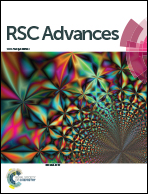First-principles study of small Pd–Au alloy clusters on graphene
Abstract
We performed extensive density functional theory (DFT) calculations of palladium (Pd) and gold (Au) alloy clusters adsorbed on a graphene monolayer in order to clarify the geometries and charge transfer of Pd–Au bimetal alloy clusters on graphene. It is found that the Pd–Au cluster prefers to bind with graphene through Pd atoms, with strong p-d hybridization between graphene and Pd atoms. Although the gold atom has an unpaired electron, the magnetic moments are mainly contributed by palladium. Compared with Pd–Au bimetal, the bonds between Au atoms are stronger; therefore, the gold atoms form a gold cap covering the Pd cluster. Furthermore, Bader charge analysis demonstrates that Pd in alloy clusters tends to lose electrons, and the number of charge transfers increases with the introduction of the graphene monolayer. Gold atoms and graphene synergistically improve electron loss on the Pd atom, thus weakening the adsorption of anions, which is expected to prevent poisoning of Pd nanocatalysts and enhance the catalytic reactivity of alloy clusters. However, the Au–Au coupling could weaken their ability to gain electrons from Pd significantly. So, an important task for experimental research is to find a way to disperse gold atoms as far apart as possible to improve the catalytic properties of the Pd–Au alloy cluster.


 Please wait while we load your content...
Please wait while we load your content...